News
Volunteer boatmen, religious groups join hands to provide food to victims
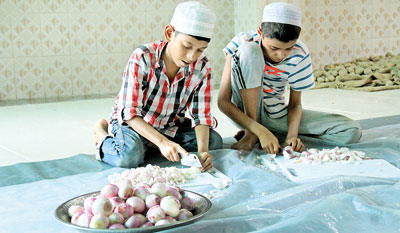
Two young boys chop onions on floor of mosque. Pix by Amila Gamage and Indika Handuwala
Wading thigh-high through a fetid pool, a young man delivers lunch packets to the residents of flood-hit Nagahamulla Road in Wellampitiya. He makes several trips through the putrid stew to ensure that nobody goes hungry.
This is not river water. The black liquid the man is crawling through is drainage overflow and runoff from the Meetotamulla garbage dump which had streamed into the lane via a nearby canal. The air smells foul. But the man carries on.
Some distance away, at the Kolonnawa Jumma Masjid, the faithful are performing their ablutions before noon prayer. The mosque hall has become a temporary storehouse for dry rations and other donated goods. Seated on plastic sheets, oblivious to the activity around them, two small boys are chopping onions.
I.Y.M. Haniff, President of the Federation of Mosques of Kolonnawa, leads the way to an open area upstairs where a shed has been erected. A large cauldron of fragrant yellow rice is on the fire. This is where, over the past three days, thousands of packs of lunch and dinner had been cooked for flood victims in Wellampitiya and surrounding areas.
There is more activity at the Anandarama Buddhist Temple in Salamulla. That morning, volunteers from the Kolonnawa Jumma Masjid had shared provisions with the temple. Some villagers stirred a vat of rice with a paddle. Others cut onions, extracted coconut milk and opened countless cans of tinned fish. The menu: breadfruit curry, tinned fish and coconut sambol.
Wellampitiya was a transformed town. In adversity, people had teamed up. For much of the week, the streets were packed with residents fleeing the flood with a few possessions. Hundreds of others flocked there out of curiosity, to witness for themselves how the Kelani River had swelled its banks and swamped settlements for miles around.
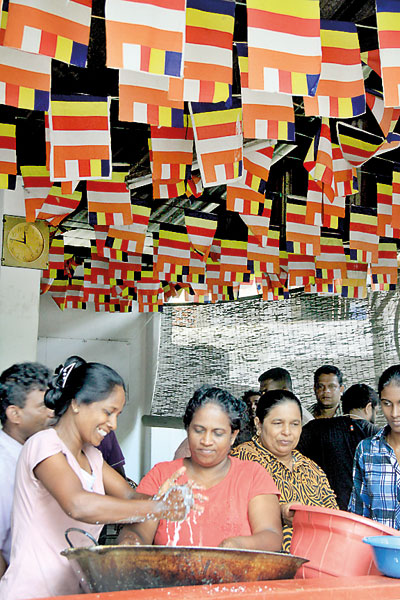
Cooking at Anandarama Temple in Salamulla
“One of the biggest problems we have now is these tourists,” said Aslam Othman, President of the Colombo District Masjid Federation, who was helping in relief efforts. “They take food and water intended for the victims.”
But provisions were aplenty. Cartons of bottled water, boxes of biscuits, bags of dry rations and an endless supply of packed meals were seen flowing into Wellampitiya. It is not certain whether they all reached the intended recipients.
The rains had started on Sunday, May 15, and the river encroached steadily upon the land. Residents said they did not think the waters would rise so high. But by Monday, it became clear that most single-storey buildings didn’t stand a chance. According to boatmen, the river had flowed at least 2.5 kilometres inland from Wellampitiya to beyond Buthgamuwa and Kohilawatte. And it was taking ages to recede.
On Thursday, evacuations were happening in earnest. Twenty-three-year-old Sameera Danushka, a fisherman from Elakanda, Wattala, watched the scene tiredly. He was seated on the edge of his boat, dripping with exhaustion.
“I worked throughout the night, ferrying people out of their homes,” he said. “We started at five in the evening yesterday.” Sameera had volunteered his boat after learning that families were trapped in the flood. “Somebody came and asked for the boat,” he said. Now, he needed a lorry to take it back but there wasn’t one in sight. “You don’t have a lorry, do you,” he joked, with a weak grin.
The All Ceylon Jamiyyathul Ulama (ACJU) had organised private boats from Negombo, Elakanda and Beruwala before the Navy had moved in. Many of these sustained damages to their hulls after dashing against walls, lampposts and hidden obstructions in the water. Some were being repaired on site.
Abdul Hameed, a 52-year-old businessman, was with a group of men distributing biscuits to families disembarking from boats and dinghies. He was damp. But he was energetic and smiling. “I lost everything in the flood, all my possessions,” he said. “The water rose up to our roof. Our documents, birth certificates, they are all gone. But these are our brothers and sisters. Everyone was caught together in this disaster.”
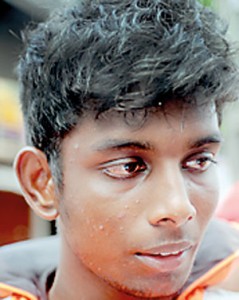
Anjana Udayanga
Anjana Udayanga, a 19-year-old from Borella Susamayawardhana Vidyalaya, was also volunteering. He was from Kohilawatte. He had two younger brothers and a younger sister. Three days earlier, he had left them with his parents on the second-storey of their house. They hadn’t wanted to evacuate.
If there was any danger, Anjana said, they would clamber onto the third storey of a nearby building. His time was now occupied with distributing food and water to others like his family that hadn’t wanted to leave their homes. He spent the nights on the floor of a hardware shop in Kolonnnawa. His days stretched from about 10 am to 8 pm.
Indeed, many families with houses of two stories or higher had not wanted to abandon their properties. This was evident from a boat ride through waterlogged settlements in Wellampitiya on Friday. People were perched on slabs or seated in balconies, watching the scenes below. Single storey houses were all under water, with levels rising up to or above their roofs.
“Do you have drinking water?” shouted one woman, as the boat passed by. “We don’t need food. We got food.” By Friday, boats—both private and Navy-owned—were making round-the-clock trips to deliver food, water and other provisions to people who had chosen to stay behind. In some parts of Wellampitiya, there were even scenes of mirth as kids splashed about.
“Don’t play in this water, children,” implored Father Vincent Ashley, a Catholic priest from St. Sebastian’s College in Moratuwa, who was taking the boat to deliver much-needed supplies to St. Mary’s in Wellampitiya. The church and its buildings were partially flooded.
“Don’t you realise what you’re wallowing in?” said a Navy sailor to some girls who were chest-high in the flood. “There was even a dead dog in here, somewhere.” It was evident that some had not grasped the dangers of immersing themselves in the murky brown water. Then again, many had no choice.
People had stayed behind to protect their belongings from drug addicts, explained V.S. Ajith, a 60-year-old owner of three grocery shops. “Even I waited as long as I could,” he said.
“I only left when it was clear that I could not save my shops.”
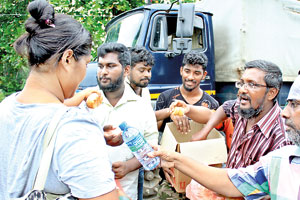
Abdul Hameed distributes water and food
Pointing at a scraggy man in shorts who was heading into the water, Ajith whispered, “See, that’s a number one drug addict. We know what they are up to. They take go in tubes to rob houses. It will get worse when the water starts getting shallower.”
Prime Minister Ranil Wickremesinghe had promised security to homes and businesses but it was practically impossible to deploy troops all over flooded settlements. Even on Friday, the levels were more than eight feet high in some places.
Mr. Othman warned that there could still be people marooned in the interior, along narrow by-lanes that were inaccessible by boat. From early on, the ACJU had set up a desk to take down the names, locations and telephone numbers of persons who wanted to get out (based on information their relatives on dry land provided). These were sent with boatmen who then faced the daunting task of locating addresses in villages that were under water. But after several days, and with no electricity, it was becoming more difficult to make contact.
As Mr. Othman speaks, a woman in a black chador arrives at the desk. She had left her home in Megoda Kolonnawa with her husband and 11-year-old son around 3.30 p.m. on May 16—when the water level was up her chest. Now her house is completely under water. What will happen to their belongings, she asks.
“We have nothing, no shoes, no clothes, my son’s school things, nothing,” the woman, 40-year-old Fathima Jezmin, says. And she starts to cry. Like many others in her situation, it will be long before the scars heal. Lifetimes of earnings are gone.
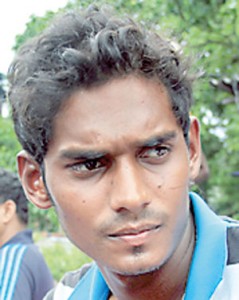
Sameera DanushkaFathima JezminI.Y.M Haniff

